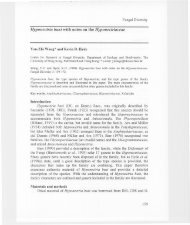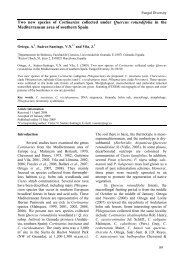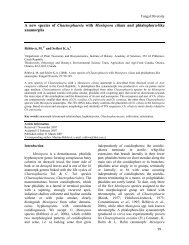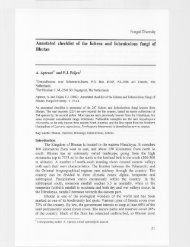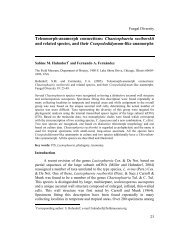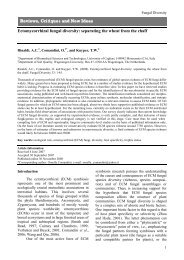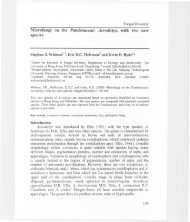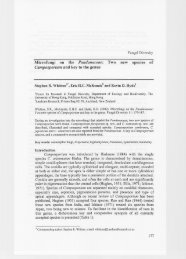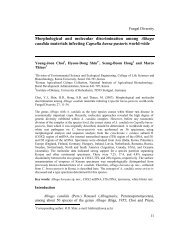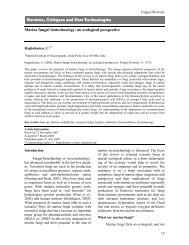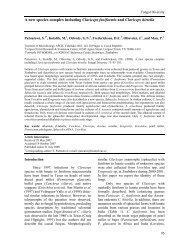Phylogeny and morphology of Diplodia species on ... - Fungal diversity
Phylogeny and morphology of Diplodia species on ... - Fungal diversity
Phylogeny and morphology of Diplodia species on ... - Fungal diversity
Create successful ePaper yourself
Turn your PDF publications into a flip-book with our unique Google optimized e-Paper software.
<strong>Fungal</strong> Diversity<br />
<str<strong>on</strong>g>Phylogeny</str<strong>on</strong>g> <str<strong>on</strong>g>and</str<strong>on</strong>g> <str<strong>on</strong>g>morphology</str<strong>on</strong>g> <str<strong>on</strong>g>of</str<strong>on</strong>g> <str<strong>on</strong>g>Diplodia</str<strong>on</strong>g> <str<strong>on</strong>g>species</str<strong>on</strong>g> <strong>on</strong> olives in southern Italy <str<strong>on</strong>g>and</str<strong>on</strong>g><br />
descripti<strong>on</strong> <str<strong>on</strong>g>of</str<strong>on</strong>g> <str<strong>on</strong>g>Diplodia</str<strong>on</strong>g> olivarum sp. nov.<br />
Lazzizera, C. 1 , Frisullo, S. 1 , Alves, A. 2 , Lopes, J. 3 <str<strong>on</strong>g>and</str<strong>on</strong>g> Phillips, A.J.L. 3*<br />
1<br />
Dipartimento di Scienze Agro-Ambientali, Chimica e Difesa Vegetale, Facoltà di Agraria, Università degli Studi di<br />
Foggia, Via Napoli, 25-71100 Foggia, Italy<br />
2<br />
CESAM & Departamento de Biologia, Universidade de Aveiro, Campus Universitário de Santiago, 3810-193 Aveiro,<br />
Portugal<br />
3<br />
Centro de Recursos Microbiológicos, Faculdade de Ciências e Tecnologia, Universidade Nova de Lisboa, 2829-516,<br />
Caparica, Portugal<br />
Lazzizera, C., Frisullo, S., Alves A., Lopes, J., <str<strong>on</strong>g>and</str<strong>on</strong>g> Phillips, A. J. L. (2008). <str<strong>on</strong>g>Phylogeny</str<strong>on</strong>g> <str<strong>on</strong>g>and</str<strong>on</strong>g> <str<strong>on</strong>g>morphology</str<strong>on</strong>g> <str<strong>on</strong>g>of</str<strong>on</strong>g> <str<strong>on</strong>g>Diplodia</str<strong>on</strong>g><br />
<str<strong>on</strong>g>species</str<strong>on</strong>g> <strong>on</strong> olives in southern Italy <str<strong>on</strong>g>and</str<strong>on</strong>g> descripti<strong>on</strong> <str<strong>on</strong>g>of</str<strong>on</strong>g> <str<strong>on</strong>g>Diplodia</str<strong>on</strong>g> olivarum sp. nov. <strong>Fungal</strong> Diversity 31: 63-71.<br />
During a recent study <str<strong>on</strong>g>of</str<strong>on</strong>g> Botryosphaeria <str<strong>on</strong>g>and</str<strong>on</strong>g> Ne<str<strong>on</strong>g>of</str<strong>on</strong>g>usicoccum <str<strong>on</strong>g>species</str<strong>on</strong>g> <strong>on</strong> olives, a number <str<strong>on</strong>g>of</str<strong>on</strong>g> <str<strong>on</strong>g>Diplodia</str<strong>on</strong>g> <str<strong>on</strong>g>species</str<strong>on</strong>g> were<br />
isolated. Most <str<strong>on</strong>g>of</str<strong>on</strong>g> these were <str<strong>on</strong>g>Diplodia</str<strong>on</strong>g> seriata while others resembled <str<strong>on</strong>g>Diplodia</str<strong>on</strong>g> mutila in their hyaline, aseptate, thickwalled<br />
c<strong>on</strong>idia. These latter isolates were morphologically (c<strong>on</strong>idial dimensi<strong>on</strong>s) <str<strong>on</strong>g>and</str<strong>on</strong>g> phylogenetically (ITS <str<strong>on</strong>g>and</str<strong>on</strong>g> EF1-α<br />
sequences) distinct from other <str<strong>on</strong>g>Diplodia</str<strong>on</strong>g> <str<strong>on</strong>g>species</str<strong>on</strong>g> <str<strong>on</strong>g>and</str<strong>on</strong>g> are described here as <str<strong>on</strong>g>Diplodia</str<strong>on</strong>g> olivarum sp. nov.<br />
Key words: Botryosphaeriaceae, ITS, Olea europaea, phylogeny, tax<strong>on</strong>omy<br />
Article Informati<strong>on</strong><br />
Received 1 February 2008<br />
Accepted 18 March 2008<br />
Published <strong>on</strong>line 31 July 2008<br />
* Corresp<strong>on</strong>ding author: Alan Phillips; e-mail: alp@fct.unl.pt<br />
Introducti<strong>on</strong><br />
Species <str<strong>on</strong>g>of</str<strong>on</strong>g> <str<strong>on</strong>g>Diplodia</str<strong>on</strong>g> have a worldwide<br />
distributi<strong>on</strong> <str<strong>on</strong>g>and</str<strong>on</strong>g> are known to be pathogens,<br />
endophytes <str<strong>on</strong>g>and</str<strong>on</strong>g> latent pathogens <str<strong>on</strong>g>of</str<strong>on</strong>g> a variety <str<strong>on</strong>g>of</str<strong>on</strong>g><br />
woody hosts (Barr, 1987; v<strong>on</strong> Arx, 1987; Crous<br />
et al., 2006; Slippers <str<strong>on</strong>g>and</str<strong>on</strong>g> Wingfield, 2007).<br />
They are associated with various symptoms<br />
including shoot blights, dieback, cankers <str<strong>on</strong>g>and</str<strong>on</strong>g><br />
fruit rots. Some <str<strong>on</strong>g>Diplodia</str<strong>on</strong>g> <str<strong>on</strong>g>species</str<strong>on</strong>g> have wide<br />
host ranges, for example <str<strong>on</strong>g>Diplodia</str<strong>on</strong>g> seriata De<br />
Not. (=”Botryosphaeria” obtusa (Schwein.)<br />
Shoemaker) (Phillips et al., 2007), which has<br />
been recorded <strong>on</strong> more than 250 hosts (Farr et<br />
al., 2008) On the other h<str<strong>on</strong>g>and</str<strong>on</strong>g>, some <str<strong>on</strong>g>species</str<strong>on</strong>g><br />
appear to be restricted to a single host genus, or<br />
to closely related genera. For example, <str<strong>on</strong>g>Diplodia</str<strong>on</strong>g><br />
pinea (Desm.) J. Kickx fil. (= Sphaeropsis<br />
sapinea (Fr.) Dyko & B. Sutt<strong>on</strong>) <str<strong>on</strong>g>and</str<strong>on</strong>g> D.<br />
scrobiculata J. de Wet, Slippers & M.J. Wingf.<br />
occur <strong>on</strong>ly <strong>on</strong> c<strong>on</strong>ifers, D. corticola A.J.L.<br />
Phillips, A. Alves & J. Luque has been found<br />
<strong>on</strong>ly <strong>on</strong> Quercus <str<strong>on</strong>g>species</str<strong>on</strong>g> (Alves et al., 2004)<br />
while <str<strong>on</strong>g>Diplodia</str<strong>on</strong>g> cupressi A.J.L. Phillips & A.<br />
Alves has been recorded <strong>on</strong>ly <strong>on</strong> Cupressus<br />
<str<strong>on</strong>g>and</str<strong>on</strong>g> Juniperus <str<strong>on</strong>g>species</str<strong>on</strong>g> (Alves et al., 2006).<br />
However, <str<strong>on</strong>g>Diplodia</str<strong>on</strong>g> mutila Fr., the type <str<strong>on</strong>g>species</str<strong>on</strong>g><br />
<str<strong>on</strong>g>of</str<strong>on</strong>g> the genus, has been associated with a variety<br />
<str<strong>on</strong>g>of</str<strong>on</strong>g> hosts (Farr et al., 2008).<br />
Based <strong>on</strong> the type <str<strong>on</strong>g>species</str<strong>on</strong>g> (D. mutila)<br />
<str<strong>on</strong>g>Diplodia</str<strong>on</strong>g> is circumscribed by having uni- or<br />
multilocular c<strong>on</strong>idiomata lined with c<strong>on</strong>idiogenous<br />
cells that form hyaline, aseptate, thickwalled<br />
c<strong>on</strong>idia at their tips (Phillips et al.,<br />
2005). Typically the c<strong>on</strong>idia remain hyaline for<br />
a l<strong>on</strong>g time before they become brown <str<strong>on</strong>g>and</str<strong>on</strong>g><br />
septate, but in D. seriata, D. pinea <str<strong>on</strong>g>and</str<strong>on</strong>g> D.<br />
scrobiculata the c<strong>on</strong>idia become brown before<br />
discharge from the pycnidia.<br />
For many years <str<strong>on</strong>g>species</str<strong>on</strong>g> in <str<strong>on</strong>g>Diplodia</str<strong>on</strong>g> were<br />
described <strong>on</strong> the basis <str<strong>on</strong>g>of</str<strong>on</strong>g> host associati<strong>on</strong> with<br />
the result that more than 1000 <str<strong>on</strong>g>species</str<strong>on</strong>g> have<br />
now been described. A search <str<strong>on</strong>g>of</str<strong>on</strong>g> MycoBank<br />
(January 2008; www.mycobank.org) revealed<br />
1176 names while Species Fungorum (January<br />
2008; www.<str<strong>on</strong>g>species</str<strong>on</strong>g>fungorum.org) lists 1236<br />
names. Since host is no l<strong>on</strong>ger c<strong>on</strong>sidered to be<br />
<str<strong>on</strong>g>of</str<strong>on</strong>g> primary importance in <str<strong>on</strong>g>species</str<strong>on</strong>g> differentiati<strong>on</strong><br />
in the Botryosphaeriaceae (Slippers et al.,<br />
2004) it is likely that many <str<strong>on</strong>g>of</str<strong>on</strong>g> these names are<br />
63
syn<strong>on</strong>yms. At present, <str<strong>on</strong>g>species</str<strong>on</strong>g> are defined<br />
according to the dimensi<strong>on</strong>s <str<strong>on</strong>g>and</str<strong>on</strong>g> colour <str<strong>on</strong>g>of</str<strong>on</strong>g> their<br />
c<strong>on</strong>idia.<br />
Species <str<strong>on</strong>g>of</str<strong>on</strong>g> <str<strong>on</strong>g>Diplodia</str<strong>on</strong>g> that occur <strong>on</strong> olives<br />
have not been studied in detail <str<strong>on</strong>g>and</str<strong>on</strong>g> <strong>on</strong>ly six<br />
reports <str<strong>on</strong>g>of</str<strong>on</strong>g> <str<strong>on</strong>g>Diplodia</str<strong>on</strong>g> <strong>on</strong> olives are listed by Farr<br />
et al. (2008). Recently, D. seriata was reported<br />
<strong>on</strong> olive drupes in Spain (Moral et al., 2008). A<br />
search <str<strong>on</strong>g>of</str<strong>on</strong>g> the literature showed that D. oleae De<br />
Not. <str<strong>on</strong>g>and</str<strong>on</strong>g> D. elaeophila Sacc. & Roum. are the<br />
<strong>on</strong>ly other <str<strong>on</strong>g>Diplodia</str<strong>on</strong>g> <str<strong>on</strong>g>species</str<strong>on</strong>g> that have been<br />
reported from this host. However, D. oleae was<br />
recently shown to be a syn<strong>on</strong>ym <str<strong>on</strong>g>of</str<strong>on</strong>g> Cole<strong>on</strong>aema<br />
oleae (DC.) Höhn. (= Coleophoma oleae<br />
(DC.) Petr. & Syd.) (Duan et al., 2007).<br />
In the present paper, <str<strong>on</strong>g>Diplodia</str<strong>on</strong>g> <str<strong>on</strong>g>species</str<strong>on</strong>g> <strong>on</strong><br />
rotting olive drupes were surveyed in the main<br />
olive producing regi<strong>on</strong>s <str<strong>on</strong>g>of</str<strong>on</strong>g> southern Italy.<br />
Phylogenetic relati<strong>on</strong>ships between the isolates<br />
were studied through analysis <str<strong>on</strong>g>of</str<strong>on</strong>g> nucleotide<br />
sequences <str<strong>on</strong>g>of</str<strong>on</strong>g> the 5.8S ribosomal gene <str<strong>on</strong>g>and</str<strong>on</strong>g> it<br />
flanking internal transcribed spacers, ITS1 <str<strong>on</strong>g>and</str<strong>on</strong>g><br />
ITS2 (ITS) <str<strong>on</strong>g>and</str<strong>on</strong>g> partial sequences <str<strong>on</strong>g>of</str<strong>on</strong>g> the translati<strong>on</strong><br />
el<strong>on</strong>gati<strong>on</strong> factor gene (EF1-α).<br />
Materials <str<strong>on</strong>g>and</str<strong>on</strong>g> methods<br />
Isolates<br />
Isolati<strong>on</strong>s were made by directly plating<br />
out pieces <str<strong>on</strong>g>of</str<strong>on</strong>g> diseased olive drupes <strong>on</strong> PDA<br />
after surface sterilizati<strong>on</strong> in 70% ethanol for 2<br />
minutes. Isolates were cultured <strong>on</strong> half-strength<br />
PDA (1/2 PDA) or <strong>on</strong> water agar supplemented<br />
with autoclaved pine needles placed <strong>on</strong> the agar<br />
surface. Cultures were kept <strong>on</strong> the laboratory<br />
bench at about 20-25°C where they received<br />
diffused daylight. Growth rates were determined<br />
<strong>on</strong> PDA plates incubated in the dark at<br />
25°C. Representative cultures <str<strong>on</strong>g>and</str<strong>on</strong>g> specimens<br />
were deposited at the Centraalbureau voor<br />
Schimmelcultures (CBS), Utrecht, The Netherl<str<strong>on</strong>g>and</str<strong>on</strong>g>s.<br />
DNA isolati<strong>on</strong> <str<strong>on</strong>g>and</str<strong>on</strong>g> amplificati<strong>on</strong><br />
DNA was isolated from fungal mycelium<br />
by the method <str<strong>on</strong>g>of</str<strong>on</strong>g> Möller et al. (1992). Procedures<br />
<str<strong>on</strong>g>and</str<strong>on</strong>g> protocols for DNA sequencing were<br />
as described in Alves et al. (2004). PCR<br />
reacti<strong>on</strong>s were carried out with Taq polymerase,<br />
nucleotides <str<strong>on</strong>g>and</str<strong>on</strong>g> buffers supplied by<br />
MBI Fermentas (Vilnius, Lithuania) <str<strong>on</strong>g>and</str<strong>on</strong>g> PCR<br />
reacti<strong>on</strong> mixtures were prepared according to<br />
64<br />
Alves et al. (2004), with the additi<strong>on</strong> <str<strong>on</strong>g>of</str<strong>on</strong>g> 5%<br />
DMSO to improve the amplificati<strong>on</strong> <str<strong>on</strong>g>of</str<strong>on</strong>g> some<br />
difficult DNA templates. All primers were<br />
synthesised by MWG Biotech AG (Ebersberg,<br />
Germany). The ITS regi<strong>on</strong> was amplified using<br />
the primers ITS1 <str<strong>on</strong>g>and</str<strong>on</strong>g> ITS4 (White et al., 1990)<br />
as described by Alves et al. (2004). The<br />
primers EF1-688F <str<strong>on</strong>g>and</str<strong>on</strong>g> EF1-986R (Alves et al.,<br />
2008) were used to amplify part <str<strong>on</strong>g>of</str<strong>on</strong>g> the translati<strong>on</strong><br />
el<strong>on</strong>gati<strong>on</strong> factor 1-alpha (EF1-α) as<br />
described by Phillips et al. (2005). The amplified<br />
PCR fragments were purified with the<br />
JETQUICK PCR Purificati<strong>on</strong> Spin Kit<br />
(GENOMED, Löhne, Germany). Both str<str<strong>on</strong>g>and</str<strong>on</strong>g>s<br />
<str<strong>on</strong>g>of</str<strong>on</strong>g> the PCR products were sequenced by STAB<br />
Vida Lda (Portugal). The nucleotide sequences<br />
were read <str<strong>on</strong>g>and</str<strong>on</strong>g> edited with FinchTV 1.4.0<br />
(http://www.geospiza.com/finchtv). Sequences<br />
were checked manually <str<strong>on</strong>g>and</str<strong>on</strong>g> nucleotide arrangements<br />
at ambiguous positi<strong>on</strong>s were clarified<br />
using both primer directi<strong>on</strong> sequences. Sequences<br />
were deposited in GenBank (Table 1) <str<strong>on</strong>g>and</str<strong>on</strong>g><br />
the alignments in TreeBase. Nucleotide sequences<br />
<str<strong>on</strong>g>of</str<strong>on</strong>g> additi<strong>on</strong>al isolates were retrieved from<br />
GenBank (Table 1).<br />
Phylogenetic analyses<br />
The sequences were aligned with ClustalX<br />
versi<strong>on</strong> 1.83 (Thomps<strong>on</strong> et al., 1997) using the<br />
following parameters: pairwise alignment gap<br />
opening = 10, gap extensi<strong>on</strong> = 0.1 <str<strong>on</strong>g>and</str<strong>on</strong>g> multiple<br />
alignment gap-opening = 10, gap extensi<strong>on</strong><br />
=0.2, delay divergent sequences = 25% <str<strong>on</strong>g>and</str<strong>on</strong>g><br />
transiti<strong>on</strong> weight = 0.5. Alignments were<br />
checked <str<strong>on</strong>g>and</str<strong>on</strong>g> manual adjustments were made<br />
where necessary.<br />
Phylogenetic analyses were d<strong>on</strong>e using<br />
PAUP* v.4.0b10 (Sw<str<strong>on</strong>g>of</str<strong>on</strong>g>ford, 2003). The trees<br />
were rooted to Botryosphaeria dothidea<br />
(Moug.: Fr.) Ces. & De Not. <str<strong>on</strong>g>and</str<strong>on</strong>g> Ne<str<strong>on</strong>g>of</str<strong>on</strong>g>usicoccum<br />
luteum (Pennycook & Samuels) Crous,<br />
Slippers & A.J.L. Phillips <str<strong>on</strong>g>and</str<strong>on</strong>g> visualized with<br />
TreeView (Page, 1996).<br />
The HKY85 nucleotide substituti<strong>on</strong> model<br />
(Hasegawa et al., 1985) was used for distance<br />
analysis. All characters were unordered <str<strong>on</strong>g>and</str<strong>on</strong>g> <str<strong>on</strong>g>of</str<strong>on</strong>g><br />
equal weight. Bootstrap values were obtained<br />
from 1000 NJ bootstrap replicates. MP<br />
analyses were performed using the heuristic<br />
search opti<strong>on</strong> with 1000 r<str<strong>on</strong>g>and</str<strong>on</strong>g>om taxa additi<strong>on</strong>s<br />
<str<strong>on</strong>g>and</str<strong>on</strong>g> tree bisecti<strong>on</strong> <str<strong>on</strong>g>and</str<strong>on</strong>g> rec<strong>on</strong>necti<strong>on</strong> (TBR) as<br />
the tree swapping algorithm. All characters
Table 1. Isolates included in the phylogenetic study.<br />
<strong>Fungal</strong> Diversity<br />
Isolate<br />
number 1 Species Host Collector Locality<br />
ITS EF<br />
CBS119049 D. seriata Vitis vinifera L. Mugnai Italy DQ458889 DQ458874<br />
CAP154 D. seriata Vitis vinifera P. Larign<strong>on</strong> France EU392303 EU392280<br />
CAP160 D. seriata Vitis vinifera L. Mugnai Italy, EU392304 EU392281<br />
CAP171 D. seriata Olea europaea S. Frisullo Italy, Puglia, Lecce, Ruffano EU392305 EU392282<br />
CAP172 D. seriata Olea europaea S. Frisullo Italy, Puglia, Lecce, Ruffano EU392287 EU392264<br />
CBS121884 D. seriata Olea europaea S. Frisullo Italy, Puglia, Lecce, Lucugnano EU392288 EU392265<br />
CBS121885 D. seriata Olea europaea S. Frisullo Italy, Puglia, Lecce, Casarano EU392289 EU392266<br />
CAP206 D. seriata Olea europaea S. Frisullo Italy, Puglia, Lecce, Ruffano EU392290 EU392267<br />
CAP207 D. seriata Olea europaea S. Frisullo Italy, Puglia, Lecce, Matino EU392291 EU392268<br />
CAP208 D. seriata Olea europaea S. Frisullo Italy, Puglia, Lecce, Ugento EU392292 EU392269<br />
CAP217 D. seriata Olea europaea S. Frisullo Italy, Puglia, Lecce, Ruffano EU392293 EU392270<br />
CAP220 D. seriata Olea europaea S. Frisullo Italy, Puglia, Lecce, Felline EU392294 EU392271<br />
CAP228 D. seriata Olea europaea S. Frisullo Italy, Puglia, Lecce, Supersano EU392298 EU392275<br />
CAP229 D. seriata Olea europaea S. Frisullo Italy, Puglia, Brindisi, Brindisi EU392299 EU392276<br />
CAP230 D. seriata Olea europaea S. Frisullo Italy, Puglia, Lecce, Sp<strong>on</strong>gano EU392300 EU392277<br />
CBS112555 D. seriata Vitis vinifera A.J.L. Phillips Portugal, Alentejo, M<strong>on</strong>temor-o-Novo AY259093 AY573219<br />
CAP166 D. pinea Olea europaea S. Frisullo Italy, Basilicata, Matera, Scanzano EU392284 EU392261<br />
CAP168 D. pinea Olea europaea S. Frisullo Italy, Puglia, Lecce, Scorano EU392285 EU392262<br />
CAP169 D. pinea Olea europaea S. Frisullo Italy, Puglia, Lecce, Cutr<str<strong>on</strong>g>of</str<strong>on</strong>g>iano EU392286 EU392263<br />
CBS393.84 D. pinea "A" Pinus nigra H.A. van der Aa Netherl<str<strong>on</strong>g>and</str<strong>on</strong>g>s, Putten DQ458895 DQ458880<br />
CBS109727 D. pinea "A" Pinus radiata W.J. Swart South Africa, Stellenbosch DQ458897 DQ458882<br />
CBS109725 D. pinea "C" Pinus patula M.J. Wingfield Ind<strong>on</strong>esia, Habinsaran DQ458896 DQ458881<br />
CBS109943 D. pinea "C" Pinus patula M.J. Wingfield Ind<strong>on</strong>esia DQ458898 DQ458883<br />
CAP163 D. scrobiculata Olea europaea S. Frisullo Italy, Puglia, Lecce, Supersano EU392283 EU392260<br />
CBS109944 D. scrobiculata Pinus greggii M.J. Wingfield Mexico DQ458899 DQ458884<br />
CBS113423 D. scrobiculata Pinus greggii M.J. Wingfield Mexico DQ458900 DQ458885<br />
CAP222 D. olivarum Olea europaea S. Frisullo Italy, Puglia, Lecce, Cutr<str<strong>on</strong>g>of</str<strong>on</strong>g>iano EU392295 EU392272<br />
CAP224 D. olivarum Olea europaea S. Frisullo Italy, Puglia, Lecce, Salice Salentino EU392296 EU392273<br />
CAP225 D. olivarum Olea europaea S. Frisullo Italy, Puglia, Lecce, Campi Salentino EU392297 EU392274<br />
CBS121886 D. olivarum Olea europaea S. Frisullo Italy, Puglia, Brindisi, San Pietro Vernotico EU392301 EU392278<br />
CBS121887 D. olivarum Olea europaea S. Frisullo Italy, Puglia, Lecce, Bosco Belvedere, Scorrano EU392302 EU392279<br />
CBS230.30 D. mutila Phoenix dactylifera L.L. Huilllier U.S.A., California DQ458886 DQ458869<br />
CBS112553 D. mutila Vitis vinifera A.J.L. Phillips Portugal, Alentejo, M<strong>on</strong>temor-o-Novo AY259093 AY573219<br />
CBS168.87 D. cupressi Cupressus sempervirens Z. Solel Israel, Bet Dagan DQ458893 DQ458878<br />
CBS261.85 D. cupressi Cupressus sempervirens Z. Solel Israel, Bet Dagan DQ458894 DQ458879<br />
CBS418.64 B. tsugae Tsuga heterophylla A. Funk Canada, British Columbia DQ458888 DQ458873<br />
CBS112549 D. corticola Quercus suber A. Alves Portugal, Aveiro AY259100 AY573227<br />
GenBank 2<br />
65
Table 1 (c<strong>on</strong>tinued). Isolates included in the phylogenetic study.<br />
Isolate<br />
number 1 Species Host Collector Locality<br />
ITS EF<br />
CBS112547 D. corticola Quercus ilex M.E. Sánchez, A. Trapero Spain, Córdoba AY259110 DQ458872<br />
CBS116470 D. rosulata Prunus africana A. Gure Ethiopia, Gambo EU430265 EU430267<br />
CBS116472 D. rosulata Prunus africana A. Gure Ethiopia,Gambo EU430266 EU430268<br />
CBS110299 N. luteum Vitis vinifera A.J.L. Phillips Portugal, Oeiras AY259091 AY573217<br />
CBS110302 B. dothidea Vitis vinifera A.J.L. Phillips Portugal, Alentejo, M<strong>on</strong>temor-o-Novo AY259092 AY573218<br />
CBS120835 D. africana Prunus persica U. Damm South Africa, Western Cape, Paarl EF445343 EF445382<br />
CBS121104 D.africana Prunus persica U. Damm South Africa, Western Cape, Paarl EF445344 EF445383<br />
1<br />
Acr<strong>on</strong>yms <str<strong>on</strong>g>of</str<strong>on</strong>g> culture collecti<strong>on</strong>s: CAP – A.J.L. Phillips, Centro de Recursos Microbiológicos, Portugal; CBS – Centraalbureau voor Schimmelcultures, Utrecht, The Netherl<str<strong>on</strong>g>and</str<strong>on</strong>g>s.<br />
Cultures in bold type are ex-type.<br />
2<br />
Sequences in italics were retrieved from GenBank. All others were obtained in this study.<br />
66<br />
GenBank 2
were unordered <str<strong>on</strong>g>and</str<strong>on</strong>g> <str<strong>on</strong>g>of</str<strong>on</strong>g> equal weight <str<strong>on</strong>g>and</str<strong>on</strong>g> gaps<br />
were treated as fifth character. Branches <str<strong>on</strong>g>of</str<strong>on</strong>g><br />
zero length were collapsed <str<strong>on</strong>g>and</str<strong>on</strong>g> all multiple,<br />
equally parsim<strong>on</strong>ious trees were saved. The<br />
robustness <str<strong>on</strong>g>of</str<strong>on</strong>g> the most parsim<strong>on</strong>ious trees was<br />
evaluated by 1000 bootstrap replicati<strong>on</strong>s (Hillis<br />
<str<strong>on</strong>g>and</str<strong>on</strong>g> Bull, 1993). Other measures used were<br />
c<strong>on</strong>sistency index (CI), retenti<strong>on</strong> index (RI), <str<strong>on</strong>g>and</str<strong>on</strong>g><br />
homoplasy index (HI). A partiti<strong>on</strong> homogeneity<br />
test was d<strong>on</strong>e in PAUP to assess the validity <str<strong>on</strong>g>of</str<strong>on</strong>g><br />
combining the ITS <str<strong>on</strong>g>and</str<strong>on</strong>g> EF1-α data.<br />
Results<br />
Phylogenetic analyses<br />
Approximately 550 <str<strong>on</strong>g>and</str<strong>on</strong>g> 300 bases were<br />
determined for the ITS <str<strong>on</strong>g>and</str<strong>on</strong>g> EF1-α genes,<br />
respectively. New sequences were deposited in<br />
GenBank (Table 1) <str<strong>on</strong>g>and</str<strong>on</strong>g> the alignments in<br />
TreeBase (SN3760). The sequence alignment<br />
<str<strong>on</strong>g>of</str<strong>on</strong>g> 44 isolates (Table 1), including the two<br />
outgroup isolates, c<strong>on</strong>sisted <str<strong>on</strong>g>of</str<strong>on</strong>g> 552 characters<br />
for the ITS regi<strong>on</strong> <str<strong>on</strong>g>and</str<strong>on</strong>g> 332 for the EF1-α gene<br />
including alignment gaps. A partiti<strong>on</strong> homogeneity<br />
test showed no significant differences<br />
(P = 0.330) between the data from the two gene<br />
regi<strong>on</strong>s indicating that they could be combined<br />
in a single dataset.<br />
The combined dataset c<strong>on</strong>sisted <str<strong>on</strong>g>of</str<strong>on</strong>g> 844<br />
characters <str<strong>on</strong>g>of</str<strong>on</strong>g> which 562 were c<strong>on</strong>stant <str<strong>on</strong>g>and</str<strong>on</strong>g> 76<br />
were parsim<strong>on</strong>y-uninformative. Maximum<br />
parsim<strong>on</strong>y analysis <str<strong>on</strong>g>of</str<strong>on</strong>g> the remaining 206 parsim<strong>on</strong>y-informative<br />
characters resulted in two<br />
trees <str<strong>on</strong>g>of</str<strong>on</strong>g> 428 steps with low levels <str<strong>on</strong>g>of</str<strong>on</strong>g> homoplasy<br />
(HI = 0.150). NJ analysis resulted in a tree with<br />
the same topology as the MP tree. The MP tree<br />
(Fig. 1) c<strong>on</strong>sists <str<strong>on</strong>g>of</str<strong>on</strong>g> two major clades, <strong>on</strong>e that<br />
corresp<strong>on</strong>ds to <str<strong>on</strong>g>species</str<strong>on</strong>g> with c<strong>on</strong>idia that darken<br />
before discharge <str<strong>on</strong>g>and</str<strong>on</strong>g> remain mostly aseptate<br />
(clade A), <str<strong>on</strong>g>and</str<strong>on</strong>g> another (clade B) that corresp<strong>on</strong>ds<br />
to <str<strong>on</strong>g>species</str<strong>on</strong>g> with c<strong>on</strong>idia that remain hyaline<br />
for a c<strong>on</strong>siderable time before darkening <str<strong>on</strong>g>and</str<strong>on</strong>g><br />
becoming <strong>on</strong>e-septate <strong>on</strong>ly after discharge.<br />
Clade A was composed <str<strong>on</strong>g>of</str<strong>on</strong>g> three sub-clades that<br />
corresp<strong>on</strong>d to <str<strong>on</strong>g>Diplodia</str<strong>on</strong>g> seriata, D. pinea <str<strong>on</strong>g>and</str<strong>on</strong>g><br />
D. scrobiculata. Most <str<strong>on</strong>g>of</str<strong>on</strong>g> the isolates from<br />
olives (12 isolates) fell within the D. seriata<br />
clade but three isolates grouped with D. pinea<br />
morphotype A <str<strong>on</strong>g>and</str<strong>on</strong>g> <strong>on</strong>e in a clade sister to D.<br />
scrobiculata. This latter isolate was separated<br />
from D. scrobiculata by <strong>on</strong>e bp in ITS <str<strong>on</strong>g>and</str<strong>on</strong>g> four<br />
bp in EF.<br />
<strong>Fungal</strong> Diversity<br />
Clade B was composed <str<strong>on</strong>g>of</str<strong>on</strong>g> six sub-clades<br />
corresp<strong>on</strong>ding to “B”. tsugae, D. cupressi, D.<br />
rosulata, D. mutila, D. africana Damm &<br />
Crous <str<strong>on</strong>g>and</str<strong>on</strong>g> five isolates from olives. All six<br />
clades were supported by moderately high NJ<br />
<str<strong>on</strong>g>and</str<strong>on</strong>g> MP bootstrap values. Since the isolates<br />
from olives were phylogenetically <str<strong>on</strong>g>and</str<strong>on</strong>g> morphologically<br />
distinct from the other <str<strong>on</strong>g>species</str<strong>on</strong>g> in this<br />
clade they are described here as new.<br />
Morphology<br />
<str<strong>on</strong>g>Diplodia</str<strong>on</strong>g> olivarum A.J.L. Phillips, Frisullo &<br />
Lazzizera, sp. nov. (Figs 2-7)<br />
MycoBank 511402<br />
Etymology: Named after its host the European<br />
olive.<br />
<str<strong>on</strong>g>Diplodia</str<strong>on</strong>g>e mutilae similis sed c<strong>on</strong>idiis minoribus<br />
(21.5-)22-27.5(-28.5) × (10-)11-13.5(-14.5), in medio<br />
24.4 × 12.4 µm.<br />
C<strong>on</strong>idiomata pycnidial, produced <strong>on</strong> pine<br />
needles <strong>on</strong> WA after 7-14 days, solitary,<br />
globose to ovoid, dark brown to black, up to<br />
150 µm wide, wall composed <str<strong>on</strong>g>of</str<strong>on</strong>g> dark brown,<br />
thick-walled textura angularis, becoming thinwalled<br />
<str<strong>on</strong>g>and</str<strong>on</strong>g> hyaline towards the inner regi<strong>on</strong>,<br />
semi-immersed to erumpent, unilocular, with a<br />
short neck. Ostiole circular, central. C<strong>on</strong>idiophores<br />
hyaline, cylindrical, 10-15 × 3.5-5 µm.<br />
C<strong>on</strong>idiogenous cells 8-12 × 3-6 µm, hyaline,<br />
cylindrical, holoblastic forming a single<br />
c<strong>on</strong>idium at the tip, proliferating internally to<br />
form periclinal thickenings or proliferating<br />
percurrently giving rise to 2-3 annellati<strong>on</strong>s.<br />
C<strong>on</strong>idia hyaline, aseptate, smooth, thickwalled,<br />
obl<strong>on</strong>g to oval, widest in the middle,<br />
apex broadly rounded, base rounded or truncate,<br />
rarely becoming pale brown, internally<br />
verruculose, <strong>on</strong>e septate after discharge from<br />
the pycnidia, (21.5-)22-27.5(-28.5) × (10-)11-<br />
13.5(-14.5) µm, 95% c<strong>on</strong>fidence intervals =<br />
23.9-24.8 × 12.2-12.7 µm, x ± S.D. = 24.4 ±<br />
1.6 × 12.4 ± 1 µm, L/W = 1.97 ± 0.17.<br />
Teleomorph: not seen.<br />
Habitat: On drupes <str<strong>on</strong>g>of</str<strong>on</strong>g> Olea europaea.<br />
Known distributi<strong>on</strong>: Italy.<br />
Material examined: ITALY, Puglia, Lecce,<br />
Scorrano, Basco Belvedere, <strong>on</strong> rotting drupes <str<strong>on</strong>g>of</str<strong>on</strong>g> Olea<br />
europaea, December 2004, S. Frisullo (CBS-H 19914;<br />
holotype designated here, culture ex-type CBS 121887<br />
= CAP254). Other isolates are given in Table 1.<br />
Notes: This <str<strong>on</strong>g>species</str<strong>on</strong>g> is similar to D. mutila<br />
but the two <str<strong>on</strong>g>species</str<strong>on</strong>g> can be distinguished <strong>on</strong><br />
67
100/100<br />
68<br />
10 changes<br />
Clade A<br />
83/53<br />
Clade B<br />
CBS112555 Vitis<br />
CAP220 Olea<br />
62/60 CAP217 Olea<br />
CAP172 Olea<br />
CAP171 Olea<br />
CAP154 Vitis<br />
CAP228 Olea<br />
CBS119049 Vitis<br />
CAP207 Vitis<br />
95/98<br />
100/99<br />
63/63<br />
66/66<br />
94/95<br />
96/92<br />
CAP206 Olea<br />
CBS121885 Olea<br />
CAP229 Olea<br />
CAP160 Vitis<br />
D. seriata<br />
CAP230 Olea<br />
CBS121884 Olea<br />
CAP208 Olea<br />
CBS109725<br />
morphotype C<br />
CBS109943<br />
CBS393.84<br />
CAP168 Olea<br />
CBS109727 morphotype A<br />
CAP169 Olea<br />
CAP166 Olea<br />
CBS109944<br />
CBS113423<br />
CAP163 Olea<br />
D. scrobiculata<br />
99/97<br />
CAP222 Olea<br />
CBS121887 Olea<br />
CBS121886 Olea D. olivarum<br />
63/0<br />
CAP225 Olea<br />
CAP224 Olea<br />
81/71<br />
99/98<br />
100/99 CBS230.30<br />
CBS112553<br />
D. mutila<br />
99/98 CBS121104<br />
CBS120835<br />
D. africana<br />
53/80<br />
100/100 CBS116472<br />
CBS116470<br />
D. rosulata<br />
56/88<br />
100/100<br />
CBS168.87<br />
CBS261.85<br />
CBS418.64“B.”<br />
tsugae<br />
100/100<br />
CBS112547<br />
CBS112549<br />
D. corticola<br />
Ne<str<strong>on</strong>g>of</str<strong>on</strong>g>usicoccum luteum CBS110299<br />
Botryosphaeria dothidea CBS110302<br />
Outgroup<br />
D. pinea<br />
D. cupressi<br />
Fig. 1. One <str<strong>on</strong>g>of</str<strong>on</strong>g> two most parsim<strong>on</strong>ious trees obtained from the combined analysis <str<strong>on</strong>g>of</str<strong>on</strong>g> ITS <str<strong>on</strong>g>and</str<strong>on</strong>g> EF1-α sequence data.<br />
Bootstrap values from 1000 pseudoreplicates are given at the nodes followed by NJ bootstrap values.
<strong>Fungal</strong> Diversity<br />
Figs 2-7. <str<strong>on</strong>g>Diplodia</str<strong>on</strong>g> olivarum (from holotype). 2. C<strong>on</strong>idioma formed <strong>on</strong> pine needles in culture. 3-5. C<strong>on</strong>idiogenous<br />
cells with developing c<strong>on</strong>idia. 6. Hyaline, aseptate c<strong>on</strong>idia. 7. Brown, <strong>on</strong>e septate c<strong>on</strong>idia <str<strong>on</strong>g>and</str<strong>on</strong>g> <strong>on</strong>e hyaline, aseptate<br />
c<strong>on</strong>idium. Bars: 2 = 100 µm; 3-7 = 10 µm.<br />
minor differences in the dimensi<strong>on</strong>s <str<strong>on</strong>g>of</str<strong>on</strong>g> their<br />
c<strong>on</strong>idia. Although the ranges <str<strong>on</strong>g>of</str<strong>on</strong>g> dimensi<strong>on</strong>s overlap<br />
c<strong>on</strong>siderably, mean dimensi<strong>on</strong>s <str<strong>on</strong>g>of</str<strong>on</strong>g> c<strong>on</strong>idia<br />
<str<strong>on</strong>g>of</str<strong>on</strong>g> D. olivarum are smaller than D. mutila.<br />
Discussi<strong>on</strong><br />
This study revealed four <str<strong>on</strong>g>Diplodia</str<strong>on</strong>g> <str<strong>on</strong>g>species</str<strong>on</strong>g>,<br />
D. seriata, D. pinea, D. scrobiculata <str<strong>on</strong>g>and</str<strong>on</strong>g> D.<br />
olivarum, associated with diseased olive drupes<br />
in southern Italy. These four <str<strong>on</strong>g>species</str<strong>on</strong>g> could be<br />
distinguished <strong>on</strong> DNA sequence data (ITS <str<strong>on</strong>g>and</str<strong>on</strong>g><br />
EF1-α) <str<strong>on</strong>g>and</str<strong>on</strong>g> unique morphological characteristics.<br />
Most <str<strong>on</strong>g>of</str<strong>on</strong>g> the isolates were <str<strong>on</strong>g>Diplodia</str<strong>on</strong>g> seriata.<br />
This fungus was known for many years as<br />
69
Botryosphaeria obtusa. However, in a study <str<strong>on</strong>g>of</str<strong>on</strong>g><br />
phylogenetic lineages in Botryosphaeria, Crous<br />
et al. (2006) showed that Botryosphaeria is<br />
restricted to two <str<strong>on</strong>g>species</str<strong>on</strong>g>, namely B. dothidea<br />
<str<strong>on</strong>g>and</str<strong>on</strong>g> B. corticis. As a result, the name B. obtusa<br />
was no l<strong>on</strong>ger suitable <str<strong>on</strong>g>and</str<strong>on</strong>g>, furthermore, no<br />
valid anamorph name was available for this<br />
<str<strong>on</strong>g>species</str<strong>on</strong>g>. Subsequently, Phillips et al. (2007)<br />
determined that <str<strong>on</strong>g>Diplodia</str<strong>on</strong>g> seriata was the oldest<br />
suitable name available. This fungus is known<br />
to occur <strong>on</strong> a wide range <str<strong>on</strong>g>of</str<strong>on</strong>g> hosts (Punithalingam<br />
<str<strong>on</strong>g>and</str<strong>on</strong>g> Waller, 1973) <str<strong>on</strong>g>and</str<strong>on</strong>g> to cause significant<br />
disease in some, such as apple. Farr et al.<br />
(2008) list 264 hosts under its former name <str<strong>on</strong>g>of</str<strong>on</strong>g><br />
B. obtusa. In recent years D. seriata has been<br />
recognized as a pathogen <str<strong>on</strong>g>of</str<strong>on</strong>g> Vitis vinifera in<br />
Portugal (Phillips, 1998, 2002), Australia<br />
(Castilho-P<str<strong>on</strong>g>and</str<strong>on</strong>g>o et al., 2001) <str<strong>on</strong>g>and</str<strong>on</strong>g> South Africa<br />
(van Niekerk et al., 2004). More recently it has<br />
been reported from olive drupes in Spain <str<strong>on</strong>g>and</str<strong>on</strong>g><br />
has been proved to be a pathogen <strong>on</strong> this host<br />
(Moral et al., 2008). To our knowledge, this is<br />
the first report, <str<strong>on</strong>g>of</str<strong>on</strong>g> D. seriata <strong>on</strong> O. europaea in<br />
Italy.<br />
Three isolates grouped closely with<br />
<str<strong>on</strong>g>Diplodia</str<strong>on</strong>g> pinea. This <str<strong>on</strong>g>species</str<strong>on</strong>g> is a well known<br />
pathogen <str<strong>on</strong>g>of</str<strong>on</strong>g> Pinus spp. worldwide (Punithalingam<br />
<str<strong>on</strong>g>and</str<strong>on</strong>g> Waterst<strong>on</strong>, 1970). It has also been<br />
reported <strong>on</strong> Abies, Araucaria, Chamaecyparis,<br />
Cupressus, Larix, Picea, Pseudotsuga <str<strong>on</strong>g>and</str<strong>on</strong>g><br />
Thuja (Punithalingam <str<strong>on</strong>g>and</str<strong>on</strong>g> Waterst<strong>on</strong>, 1970;<br />
Sutt<strong>on</strong>, 1980). There are also unc<strong>on</strong>firmed<br />
reports <str<strong>on</strong>g>of</str<strong>on</strong>g> it <strong>on</strong> Eucalyptus spp. in Uruguay<br />
(Bettucci et al., 1999; 2004), <str<strong>on</strong>g>and</str<strong>on</strong>g> recently it<br />
was reported <strong>on</strong> Prunus spp. in South Africa<br />
(Damm et al., 2007). The present study is the<br />
first report <str<strong>on</strong>g>of</str<strong>on</strong>g> D. pinea <strong>on</strong> O. europaea. The<br />
olive orchards sampled were surrounded by<br />
pine trees <str<strong>on</strong>g>and</str<strong>on</strong>g> it is likely that high inoculum<br />
pressure resulted in a few infecti<strong>on</strong>s <str<strong>on</strong>g>of</str<strong>on</strong>g> the<br />
olives by D. pinea. For this reas<strong>on</strong> we suspect<br />
that D. pinea is an opportunist <strong>on</strong> Olea, which<br />
should not be regarded as a major host. In a<br />
similar way, Damm et al. (2007) noted that D.<br />
pinea was isolated from pycnidia <strong>on</strong> the bark <str<strong>on</strong>g>of</str<strong>on</strong>g><br />
pruning debris <str<strong>on</strong>g>of</str<strong>on</strong>g> Prunus <str<strong>on</strong>g>and</str<strong>on</strong>g> was not associated<br />
with necrosis within the host tissue.<br />
A single isolate clustered close to D.<br />
scrobiculata, from which it differed by <strong>on</strong>e bp<br />
in ITS <str<strong>on</strong>g>and</str<strong>on</strong>g> four in EF1-α. These differences<br />
were not c<strong>on</strong>sidered to be significant <str<strong>on</strong>g>and</str<strong>on</strong>g><br />
probably represent normal variati<strong>on</strong> within D.<br />
70<br />
scrobiculata. This is the first time that D.<br />
scrobiculata has been reported <strong>on</strong> a host other<br />
than Pinus. As with D. pinea, it is probable that<br />
the high levels <str<strong>on</strong>g>of</str<strong>on</strong>g> inoculum from the surrounding<br />
pine trees resulted in this infecti<strong>on</strong> <str<strong>on</strong>g>and</str<strong>on</strong>g> it is<br />
unlikely that D. scrobiculata is a primary<br />
pathogen <str<strong>on</strong>g>of</str<strong>on</strong>g> olives.<br />
<str<strong>on</strong>g>Diplodia</str<strong>on</strong>g> olivarum is recognized as a new<br />
<str<strong>on</strong>g>species</str<strong>on</strong>g> closely related to D. mutila, D. rosulata<br />
<str<strong>on</strong>g>and</str<strong>on</strong>g> D. africana. It has morphological features<br />
typical <str<strong>on</strong>g>of</str<strong>on</strong>g> the genus, namely hyaline, aseptate,<br />
thick-walled c<strong>on</strong>idia that ultimately turn brown<br />
<str<strong>on</strong>g>and</str<strong>on</strong>g> become <strong>on</strong>e-septate (Phillips et al., 2005).<br />
Although D. olivarum resembles D. mutila <str<strong>on</strong>g>and</str<strong>on</strong>g><br />
D. rosulata, the three <str<strong>on</strong>g>species</str<strong>on</strong>g> can be separated<br />
<strong>on</strong> the size <str<strong>on</strong>g>of</str<strong>on</strong>g> their c<strong>on</strong>idia <str<strong>on</strong>g>and</str<strong>on</strong>g> col<strong>on</strong>y<br />
characters. Thus, col<strong>on</strong>ies <str<strong>on</strong>g>of</str<strong>on</strong>g> D. rosulata typically<br />
have a rosulate margin, which is not seen<br />
in the other two <str<strong>on</strong>g>species</str<strong>on</strong>g>. C<strong>on</strong>idia <str<strong>on</strong>g>of</str<strong>on</strong>g> D.<br />
olivarum are smaller than those <str<strong>on</strong>g>of</str<strong>on</strong>g> D. africana.<br />
Although the range <str<strong>on</strong>g>of</str<strong>on</strong>g> c<strong>on</strong>idial dimensi<strong>on</strong>s <str<strong>on</strong>g>of</str<strong>on</strong>g><br />
D. olivarum <str<strong>on</strong>g>and</str<strong>on</strong>g> D. mutila overlap, these two<br />
<str<strong>on</strong>g>species</str<strong>on</strong>g> can be distinguished <strong>on</strong> the mean<br />
dimensi<strong>on</strong>s, which are smaller in D. olivarum.<br />
<str<strong>on</strong>g>Diplodia</str<strong>on</strong>g> olivarum was isolated from<br />
several different olive groves in southern Italy<br />
<str<strong>on</strong>g>and</str<strong>on</strong>g> was associated with rotting drupes.<br />
However, pathogenicity has not been tested <str<strong>on</strong>g>and</str<strong>on</strong>g><br />
it is not clear if D. olivarum was the primary<br />
cause <str<strong>on</strong>g>of</str<strong>on</strong>g> the disease. Furthermore, it is not<br />
known if this fungus occurs <strong>on</strong> other hosts or if<br />
it is restricted to olives.<br />
Acknowledgements<br />
This work was financed by the European<br />
Regi<strong>on</strong>al Development Fund <str<strong>on</strong>g>and</str<strong>on</strong>g> Fundação para a<br />
Ciência e a Tecnologia (FCT) under project<br />
POCTI/AGR/56140/2004. A. Alves was supported by<br />
grant No. SFRH/BPD/24509/2005 <str<strong>on</strong>g>and</str<strong>on</strong>g> A. Phillips by<br />
grant No. SFRH/BCC/15810/2006 from FCT <str<strong>on</strong>g>and</str<strong>on</strong>g> by<br />
project "Ricerca ed Innovazi<strong>on</strong>e per l'Olivicoltura<br />
Meridi<strong>on</strong>ale-RIOM" under the program "Programma di<br />
sviluppo per il Mezzogiorno: ricerca ed innovazi<strong>on</strong>e<br />
tecnologica (delibere CIPE 17/2003 e B3/2003)".<br />
References<br />
Alves, A., Correia, A., Luque, J. <str<strong>on</strong>g>and</str<strong>on</strong>g> Phillips, A.J.L.<br />
(2004). Botryosphaeria corticola sp. nov. <strong>on</strong><br />
Quercus <str<strong>on</strong>g>species</str<strong>on</strong>g>, with notes <str<strong>on</strong>g>and</str<strong>on</strong>g> descripti<strong>on</strong> <str<strong>on</strong>g>of</str<strong>on</strong>g><br />
Botryosphaeria stevensii <str<strong>on</strong>g>and</str<strong>on</strong>g> its anamorph<br />
<str<strong>on</strong>g>Diplodia</str<strong>on</strong>g> mutila. Mycologia 96: 598-613.<br />
Alves, A., Correia, A. <str<strong>on</strong>g>and</str<strong>on</strong>g> Phillips, A.J.L. (2006).<br />
Multigene genealogies <str<strong>on</strong>g>and</str<strong>on</strong>g> morphological data
support <str<strong>on</strong>g>Diplodia</str<strong>on</strong>g> cupressi sp. nov., previously<br />
recognized as <str<strong>on</strong>g>Diplodia</str<strong>on</strong>g> pinea f. sp. cupressi as a<br />
distinct <str<strong>on</strong>g>species</str<strong>on</strong>g>. <strong>Fungal</strong> Diversity 23: 1-15.<br />
Alves, A., Crous, P.W., Correia, A. <str<strong>on</strong>g>and</str<strong>on</strong>g> Phillips, A.J.L.<br />
(2008). Morphological <str<strong>on</strong>g>and</str<strong>on</strong>g> molecular data reveal<br />
cryptic speciati<strong>on</strong> in Lasiodiplodia theobromae.<br />
<strong>Fungal</strong> Diversity 28: 1-13.<br />
Arx, J.A. v<strong>on</strong> (1987). Plant Pathogenic Fungi. J. Cramer,<br />
Berlin Germany.<br />
Barr, M.E. (1987). Prodromus to Class Loculoascomycetes.<br />
Amherst, Massachusetts: Published by<br />
the author.<br />
Bettucci, L., Al<strong>on</strong>so, R. <str<strong>on</strong>g>and</str<strong>on</strong>g> Tiscornia, S. (1999). Endophytic<br />
mycobiota <str<strong>on</strong>g>of</str<strong>on</strong>g> healthy twigs <str<strong>on</strong>g>and</str<strong>on</strong>g> the assemblage<br />
<str<strong>on</strong>g>of</str<strong>on</strong>g> <str<strong>on</strong>g>species</str<strong>on</strong>g> associated with twig lesi<strong>on</strong>s <str<strong>on</strong>g>of</str<strong>on</strong>g><br />
Eucalyptus globulus <str<strong>on</strong>g>and</str<strong>on</strong>g> E. gr<str<strong>on</strong>g>and</str<strong>on</strong>g>is in Uruguay.<br />
Mycological Research 103: 468-472.<br />
Bettucci, L., Simento, S., Al<strong>on</strong>so, R. <str<strong>on</strong>g>and</str<strong>on</strong>g> Lupo, S. (2004).<br />
Endophytic fungi <str<strong>on</strong>g>of</str<strong>on</strong>g> twigs <str<strong>on</strong>g>and</str<strong>on</strong>g> leaves <str<strong>on</strong>g>of</str<strong>on</strong>g> three<br />
native <str<strong>on</strong>g>species</str<strong>on</strong>g> <str<strong>on</strong>g>of</str<strong>on</strong>g> Myrtaceae in Uruguay. Sydowia<br />
56: 8-23.<br />
Castilho-P<str<strong>on</strong>g>and</str<strong>on</strong>g>o, M., Somers, A., Green, C.D., Priest, M.<br />
<str<strong>on</strong>g>and</str<strong>on</strong>g> Srisjathades, M. (2001). Fungi associated<br />
with a dieback <str<strong>on</strong>g>of</str<strong>on</strong>g> Semill<strong>on</strong> gravines in the Hunter<br />
Valley <str<strong>on</strong>g>of</str<strong>on</strong>g> New South Wales. Australasian Plant<br />
Pathology 30: 59-63.<br />
Crous, P.W., Slippers, B., Wingfield, M.J., Reeder, J.,<br />
Marasas, W.F.O., Phillips, A.J.L., Alves A.,<br />
Burgess, T., Barber, P. <str<strong>on</strong>g>and</str<strong>on</strong>g> Groenewald, J.Z.<br />
(2006). Phylogenetic lineages in the Botryosphaeriaceae.<br />
Studies in Mycology 55: 235-253.<br />
Damm, U., Crous, P.W. <str<strong>on</strong>g>and</str<strong>on</strong>g> Fourie, P.H. (2007). Botryosphaeriaceae<br />
as potential pathogens <str<strong>on</strong>g>of</str<strong>on</strong>g> Prunus<br />
<str<strong>on</strong>g>species</str<strong>on</strong>g> in South Africa with descipti<strong>on</strong>s <str<strong>on</strong>g>of</str<strong>on</strong>g><br />
<str<strong>on</strong>g>Diplodia</str<strong>on</strong>g> africana <str<strong>on</strong>g>and</str<strong>on</strong>g> Lasiodiplodia plurivora<br />
spp. nov. Mycologia 99: 664-680.<br />
Duan, J., Liu, X. <str<strong>on</strong>g>and</str<strong>on</strong>g> Wu, W. (2007). Reinstatement <str<strong>on</strong>g>of</str<strong>on</strong>g><br />
Cole<strong>on</strong>aema for Coleophoma oleae <str<strong>on</strong>g>and</str<strong>on</strong>g> notes <strong>on</strong><br />
Coleophoma. <strong>Fungal</strong> Diversity 26: 187-204.<br />
Farr, D.F., Rossman, A.Y., Palm, M.E., <str<strong>on</strong>g>and</str<strong>on</strong>g> McCray,<br />
E.B. (2008) <strong>Fungal</strong> Databases, Systematic Botany<br />
& Mycology Laboratory, ARS, USDA. Retrieved<br />
January 17, 2008, from http://nt.ars-grin.gov/<br />
fungaldatabases/.<br />
Hasegawa, M., Kishino, H. <str<strong>on</strong>g>and</str<strong>on</strong>g> Yano, T. (1985). Dating<br />
<str<strong>on</strong>g>of</str<strong>on</strong>g> the human-ape splitting by a molecular clock<br />
<str<strong>on</strong>g>of</str<strong>on</strong>g> mitoch<strong>on</strong>drial DNA. Journal <str<strong>on</strong>g>of</str<strong>on</strong>g> Molecular<br />
Evoluti<strong>on</strong> 22: 160-174.<br />
Hillis, D.M. <str<strong>on</strong>g>and</str<strong>on</strong>g> Bull, J.J. (1993). An empirical test <str<strong>on</strong>g>of</str<strong>on</strong>g><br />
bootstrapping as a method for assessing c<strong>on</strong>fidence<br />
in phylogenetic analysis. Systematic Biology<br />
42: 182-192.<br />
Möller, E.M., Bahnweg, G., Sndermann, H. <str<strong>on</strong>g>and</str<strong>on</strong>g> Geiger,<br />
H.H. (1992). A simple <str<strong>on</strong>g>and</str<strong>on</strong>g> efficient protocol for<br />
isolati<strong>on</strong> <str<strong>on</strong>g>of</str<strong>on</strong>g> high molecular weight DNA from<br />
filamentous fungi, fruit bodies, <str<strong>on</strong>g>and</str<strong>on</strong>g> infected plant<br />
tissues. Nucleic Acids Research 20: 6115-6116.<br />
<strong>Fungal</strong> Diversity<br />
Moral, J., Luque, F., <str<strong>on</strong>g>and</str<strong>on</strong>g> Trapero A. (2008). First report<br />
<str<strong>on</strong>g>of</str<strong>on</strong>g> <str<strong>on</strong>g>Diplodia</str<strong>on</strong>g> seriata, the anamorph <str<strong>on</strong>g>of</str<strong>on</strong>g> “Botryosphaeria”<br />
obtusa, causing fruit rot <str<strong>on</strong>g>of</str<strong>on</strong>g> olive in<br />
Spain. Plant Disease 92: 311.<br />
Page, R.D. (1996). TreeView: an applicati<strong>on</strong> to display<br />
phylogenetic trees <strong>on</strong> pers<strong>on</strong>al computers. Computer<br />
Applicati<strong>on</strong>s in the Biosciences 12: 357-<br />
358.<br />
Phillips, A.J.L. (1998). Botryosphaeria dothidea <str<strong>on</strong>g>and</str<strong>on</strong>g><br />
other fungi associated with excoriose <str<strong>on</strong>g>and</str<strong>on</strong>g> dieback<br />
<str<strong>on</strong>g>of</str<strong>on</strong>g> grapevines in Portugal. Journal <str<strong>on</strong>g>of</str<strong>on</strong>g> Phytopathology<br />
146: 327-332.<br />
Phillips, A.J.L. (2002). Botryosphaeria <str<strong>on</strong>g>species</str<strong>on</strong>g> associated<br />
with diseases <str<strong>on</strong>g>of</str<strong>on</strong>g> grapevines in Portugal.<br />
Phytopathologia Mediterranea 41: 318.<br />
Phillips, A.J.L., Alves, A., Correia, A. <str<strong>on</strong>g>and</str<strong>on</strong>g> Luque, J.<br />
(2005). Two new <str<strong>on</strong>g>species</str<strong>on</strong>g> <str<strong>on</strong>g>of</str<strong>on</strong>g> Botryosphaeria with<br />
brown, 1-septate ascospores <str<strong>on</strong>g>and</str<strong>on</strong>g> Dothiorella<br />
anamorphs. Mycologia 97: 513-529.<br />
Phillips, A.J.L., Crous, P.W. <str<strong>on</strong>g>and</str<strong>on</strong>g> Alves, A. (2007).<br />
<str<strong>on</strong>g>Diplodia</str<strong>on</strong>g> seriata, the anamorph <str<strong>on</strong>g>of</str<strong>on</strong>g> “Botryosphaeria”<br />
obtusa. <strong>Fungal</strong> Diversity 25: 141-155.<br />
Punithalingam, E, <str<strong>on</strong>g>and</str<strong>on</strong>g> Waterst<strong>on</strong>, J.M. (1970). <str<strong>on</strong>g>Diplodia</str<strong>on</strong>g><br />
pinea. Descipti<strong>on</strong>s <str<strong>on</strong>g>of</str<strong>on</strong>g> pathogenic fungi <str<strong>on</strong>g>and</str<strong>on</strong>g><br />
bacteria, No. 273. Comm<strong>on</strong>wealth Mycological<br />
Institute, Kew, Surrey, Engl<str<strong>on</strong>g>and</str<strong>on</strong>g>.<br />
Punithalingam, E. <str<strong>on</strong>g>and</str<strong>on</strong>g> Waller, J.M. (1973). Botryosphaeria<br />
obtusa. Descripti<strong>on</strong>s <str<strong>on</strong>g>of</str<strong>on</strong>g> pathogenic fungi<br />
<str<strong>on</strong>g>and</str<strong>on</strong>g> bacteria, No. 394. Comm<strong>on</strong>wealth Mycological<br />
Institute, Kew, Surrey, Engl<str<strong>on</strong>g>and</str<strong>on</strong>g>.<br />
Slippers, B., Crous, P.W., Denman, S., Coutinho, T.A.,<br />
Wingfield, B.D. <str<strong>on</strong>g>and</str<strong>on</strong>g> Wingfield, M.J. (2004).<br />
Combined multiple gene genealogies <str<strong>on</strong>g>and</str<strong>on</strong>g> phenotypic<br />
characters differentiate several <str<strong>on</strong>g>species</str<strong>on</strong>g><br />
previously identified as Botryosphaeria dothidea.<br />
Mycologia 96: 83-101.<br />
Slippers, B. <str<strong>on</strong>g>and</str<strong>on</strong>g> Wingfield, M.J. (2007). Botryosphaeriaceae<br />
as endophytes <str<strong>on</strong>g>and</str<strong>on</strong>g> latent pathogens <str<strong>on</strong>g>of</str<strong>on</strong>g><br />
woody plants: <strong>diversity</strong>, ecology <str<strong>on</strong>g>and</str<strong>on</strong>g> impact.<br />
<strong>Fungal</strong> Biology Reviews 21: 90-106.<br />
Sutt<strong>on</strong>, B.C. (1980). The Coelomycetes. Kew, UK:<br />
Comm<strong>on</strong>wealth Mycological Institute.<br />
Sw<str<strong>on</strong>g>of</str<strong>on</strong>g>ford, D.L. (2003). PAUP*. Phylogenetic Analysis<br />
Using Parsim<strong>on</strong>y (*<str<strong>on</strong>g>and</str<strong>on</strong>g> other methods) Versi<strong>on</strong><br />
4. Sunderl<str<strong>on</strong>g>and</str<strong>on</strong>g>, Massachusetts: Sinauer Associates.<br />
Thomps<strong>on</strong>, J.D., Gibs<strong>on</strong>, T.J., Plewniak, F., Jeanmougin,<br />
F. <str<strong>on</strong>g>and</str<strong>on</strong>g> Higgins, D.G. (1997). The ClustalX<br />
windows interface: flexible strategies for multiple<br />
sequence alignment aided by quality analysis<br />
tools. Nucleic Acids Research 25: 4876-4882.<br />
Van Niekerk, J.M., Crous, P.W., Groenewald, J.Z.,<br />
Fourie, P.H. <str<strong>on</strong>g>and</str<strong>on</strong>g> Halleen, F. (2004). DNA<br />
phylogeny, <str<strong>on</strong>g>morphology</str<strong>on</strong>g> <str<strong>on</strong>g>and</str<strong>on</strong>g> pathogenicity <str<strong>on</strong>g>of</str<strong>on</strong>g><br />
Botryosphaeria <str<strong>on</strong>g>species</str<strong>on</strong>g> <strong>on</strong> grapevines. Mycologia<br />
96: 781-798.<br />
71



